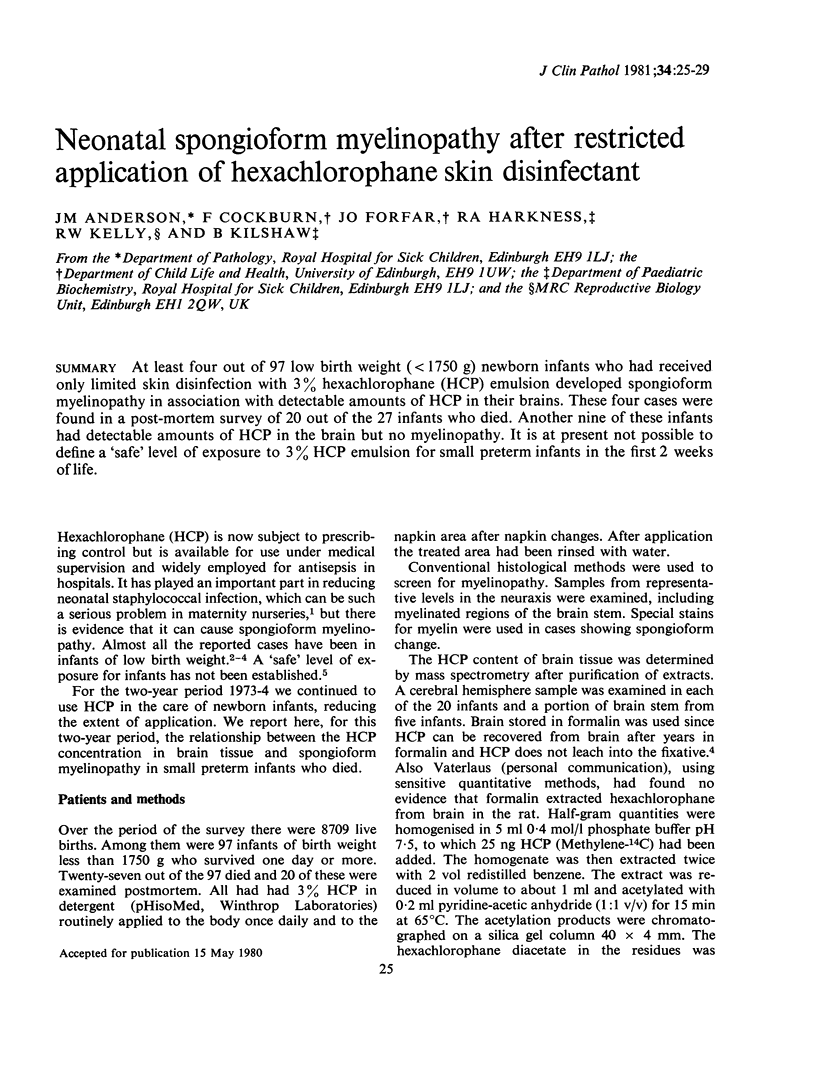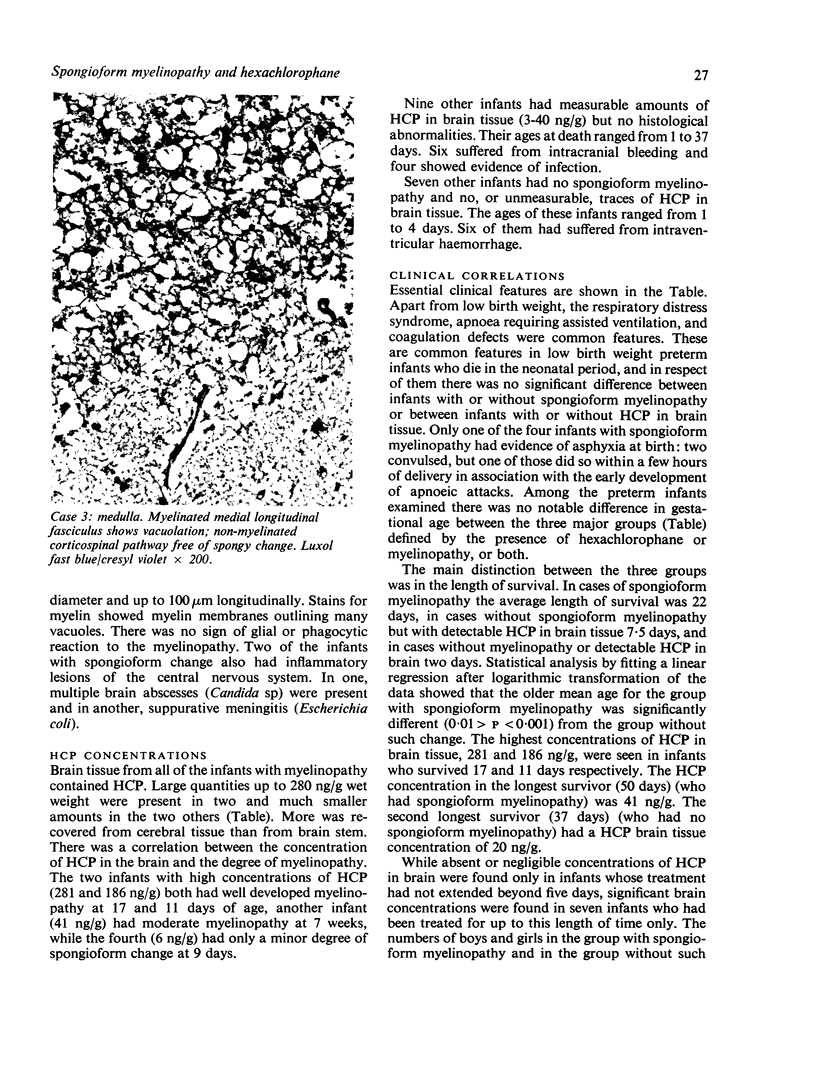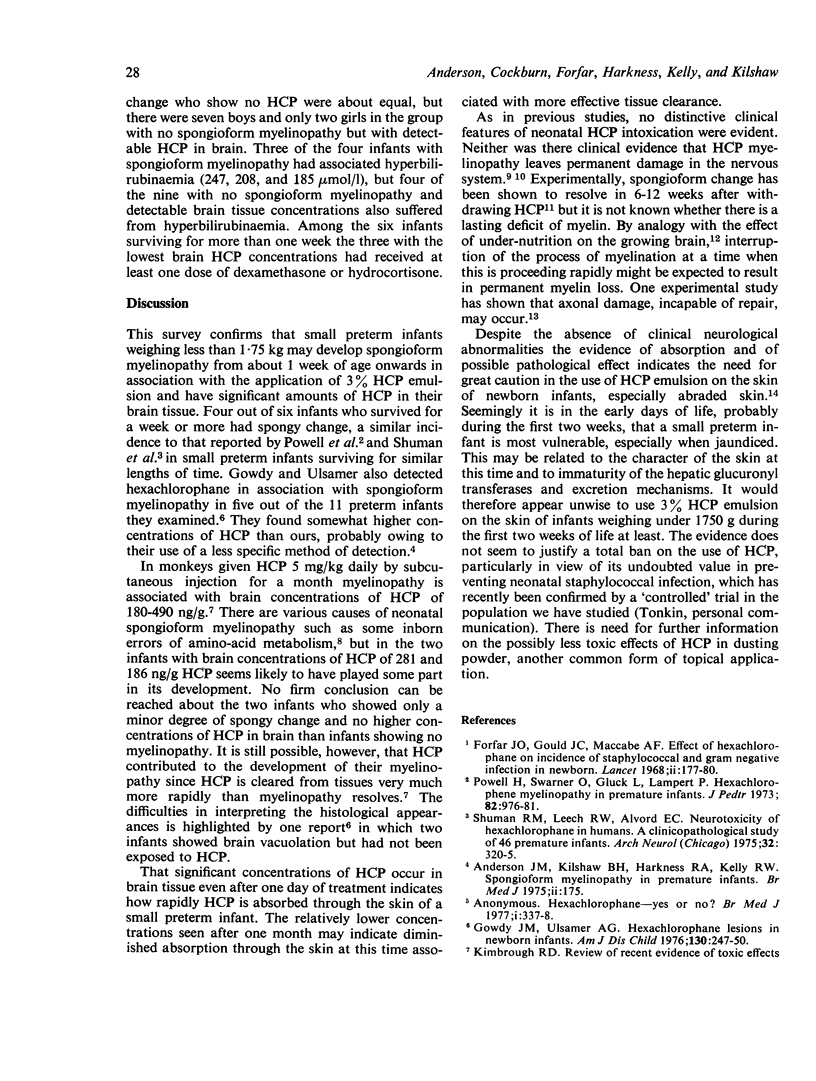Abstract
At least four out of 97 low birth weight (less than 1750 g) newborn infants who had received only limited skin disinfection with 3% hexachlorophane (HCP) emulsion developed spongioform myelinopathy in association with detectable amounts of HCP in their brains. These four cases were found in a post-mortem survey of 20 out of the 27 infants who died. Another nine of these infants had detectable amounts of HCP in the brain but no myelinopathy. It is at present not possible to define a 'safe" level of exposure to 3% HCP emulsion for small preterm infants in the first 2 weeks of life.
Full text
PDF




Images in this article
Selected References
These references are in PubMed. This may not be the complete list of references from this article.
- Anderson J. M., Kilshaw B. H., Harkness R. A., Kelly R. W. Spongioform myelinopathy in premature infants. Br Med J. 1975 Apr 26;2(5964):175–176. doi: 10.1136/bmj.2.5964.175-a. [DOI] [PMC free article] [PubMed] [Google Scholar]
- Anderson J. M. Spongy degeneration in the white matter of the central nervous system in the newborn: pathological findings in three infants, one with hyperglycinaemia. J Neurol Neurosurg Psychiatry. 1969 Aug;32(4):328–337. doi: 10.1136/jnnp.32.4.328. [DOI] [PMC free article] [PubMed] [Google Scholar]
- Forfar J. O., Gould J. C., Maccabe A. F. Effect of hexachlorophane on incidence of staphylococcal and gram-negative infection in the newborn. Lancet. 1968 Jul 27;2(7561):177–179. doi: 10.1016/s0140-6736(68)92618-4. [DOI] [PubMed] [Google Scholar]
- Gowdy J. M., Ulsamer A. G. Hexachlorophene lesions in newborn infants. Am J Dis Child. 1976 Mar;130(3):247–250. doi: 10.1001/archpedi.1976.02120040025005. [DOI] [PubMed] [Google Scholar]
- Herskowitz J., Rosman N. P. Acute hexachlorophene poisoning by mouth in a neonate. J Pediatr. 1979 Mar;94(3):495–496. doi: 10.1016/s0022-3476(79)80611-3. [DOI] [PubMed] [Google Scholar]
- Kimbrough R. D., Gaines T. B. Hexachlorophene effects on the rat brain: study of high doses by light and electron microscopy. Arch Environ Health. 1971 Aug;23(2):114–118. doi: 10.1080/00039896.1971.10665966. [DOI] [PubMed] [Google Scholar]
- Lampert P., O'Brien J., Garrett R. Hexachlorophene encephalopathy. Acta Neuropathol. 1973;23(4):326–333. doi: 10.1007/BF00687462. [DOI] [PubMed] [Google Scholar]
- Plueckhahn V. D., Collins R. B. Hexachlorophene emulsions and antiseptic skin care of newborn infants. Med J Aust. 1976 May 29;1(22):815–819. [PubMed] [Google Scholar]
- Powell H., Swarner O., Gluck L., Lampert P. Hexachlorophene myelinopathy in premature infants. J Pediatr. 1973 Jun;82(6):976–981. doi: 10.1016/s0022-3476(73)80428-7. [DOI] [PubMed] [Google Scholar]
- Shuman R. M., Leech R. W., Alvord E. C., Jr Neurotoxicity of hexachlorophene in humans. II. A clinicopathological study of 46 premature infants. Arch Neurol. 1975 May;32(5):320–325. doi: 10.1001/archneur.1975.00490470064009. [DOI] [PubMed] [Google Scholar]
- Tyrala E. E., Hillman L. S., Hillman R. E., Dodson W. E. Clinical pharmacology of hexachlorophene in newborn infants. J Pediatr. 1977 Sep;91(3):481–486. doi: 10.1016/s0022-3476(77)81330-9. [DOI] [PubMed] [Google Scholar]



